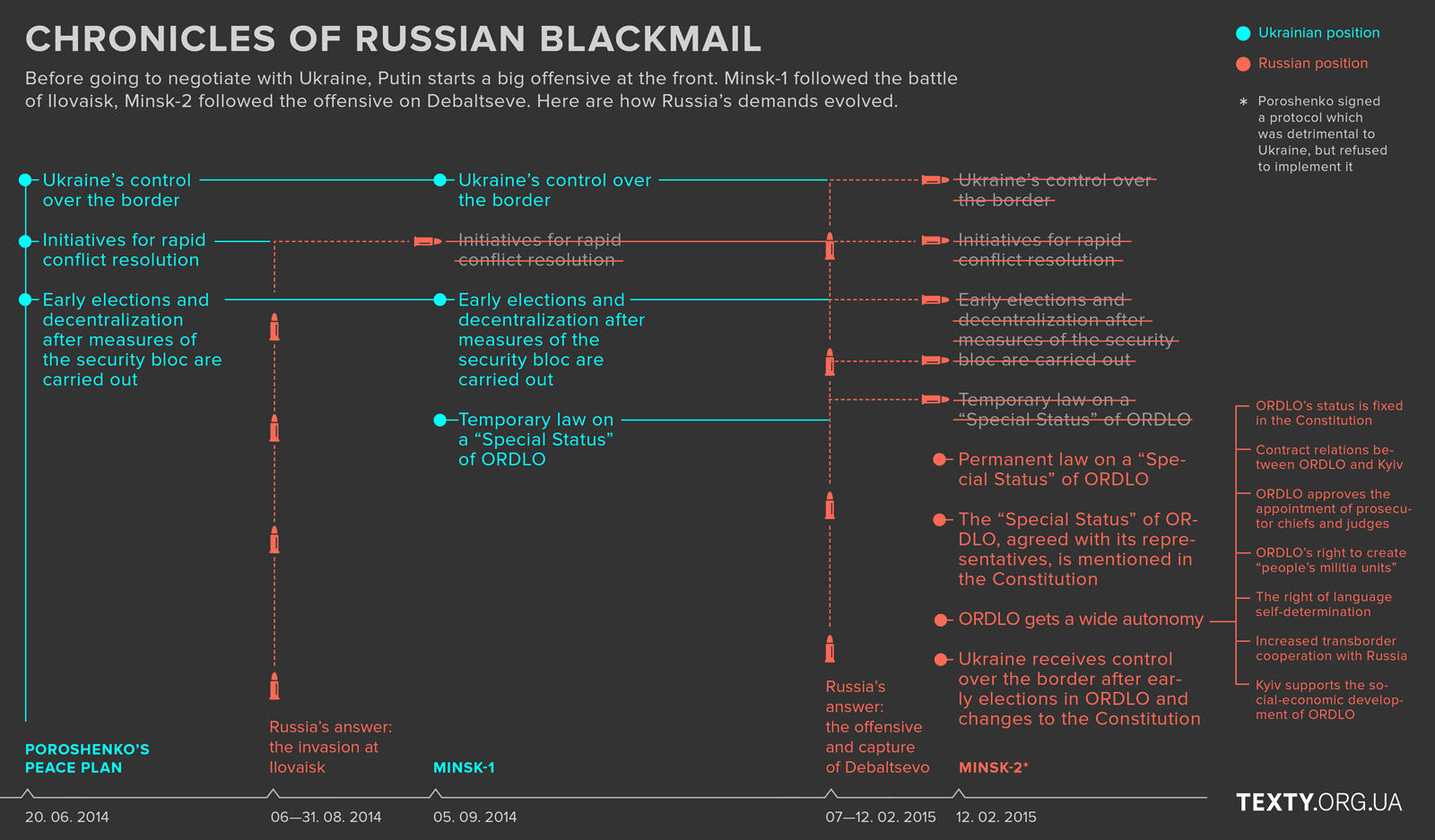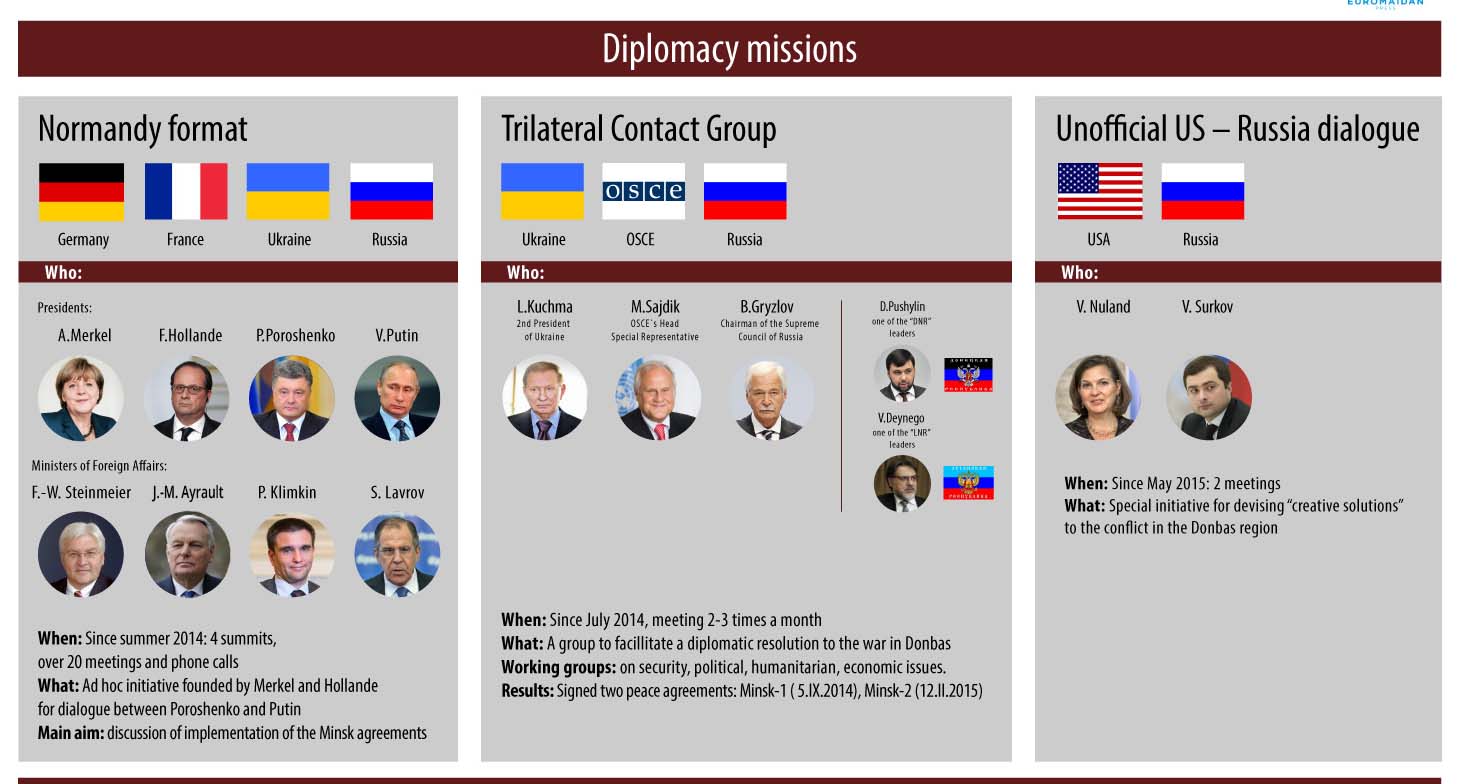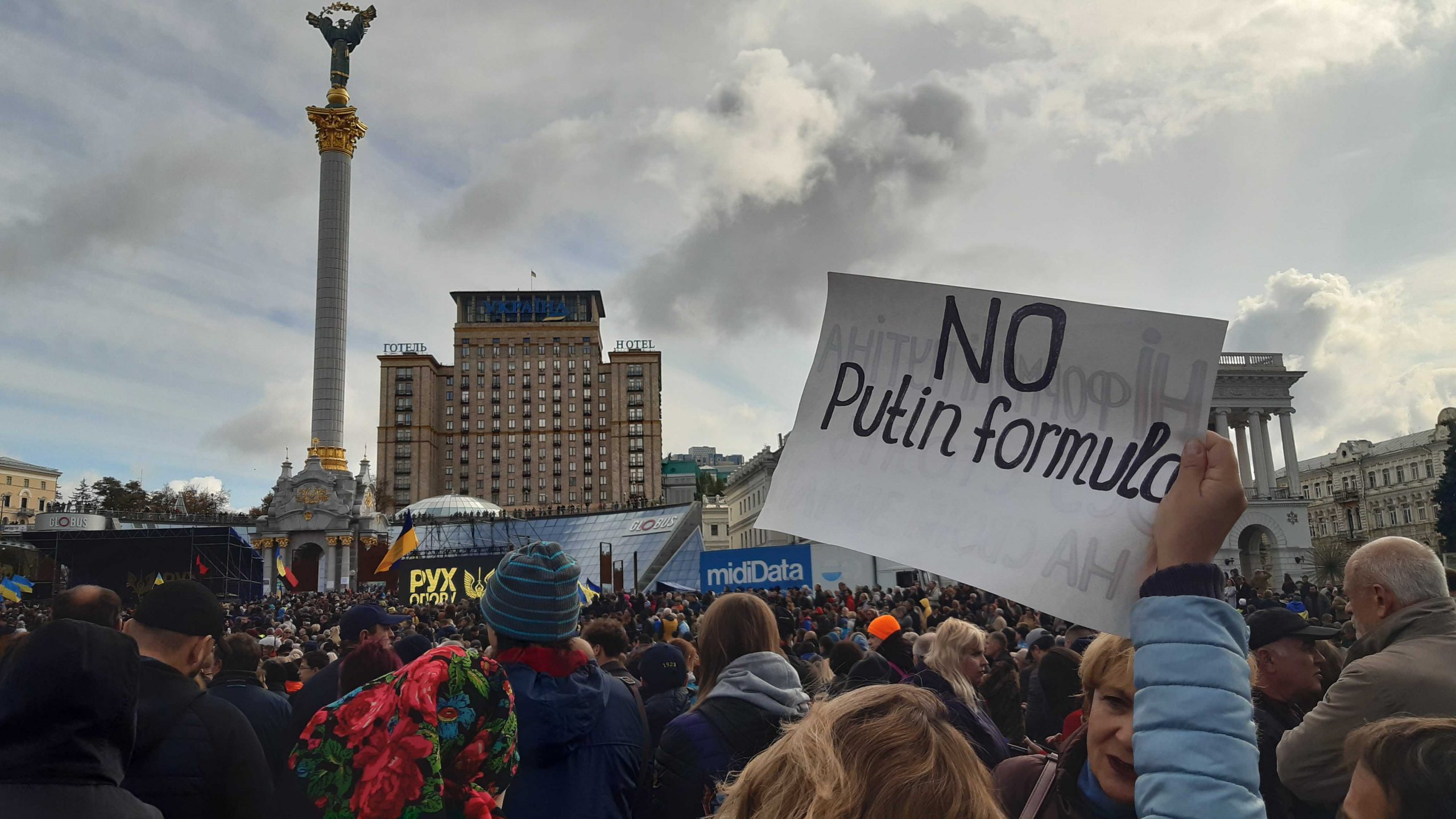Returning peace to Ukraine is the main priority of President Zelenskyy. He wishes to restore negotiations in the Normandy format and unblock the Minsk process in order to end the war in Donbas. Foreign Minister of Ukraine, Vadim Prystayko, recently stated that peace in Donbas is not possible without compromise. The president and his team have, however, stressed that the willingness to compromise is not unconditional. "We will definitely never allow the federalization of our country. We will certainly never allow the loss of our territories. We definitely want to end the war. We definitely want to reintegrate Donbas into Ukraine. We definitely want Ukraine to be united. And the whole negotiation process is built on these basic principles."
Willingness to Compromise
Russia however, does not show any sign of compromise. The strategic messaging remains unchanged and is fixed on several key messages. Putin regards Russia and Ukraine as “one people and one nation.. Russia is not a party to the conflict, which is being portrayed as a civil war. According to Putin, Ukraine should negotiate with the (so-called) separatists. Additionally, Russia insists that the political component of the Minsk protocol (special status) must be fully implemented first. Even more importantly, Russia insists that this must be achieved before they are willing to discuss the security component of the agreement. It keeps pushing for the federalization of Ukraine. As late as on 26 September, Lavrov stated that “Ukraine should not be afraid of losing its national identity if it becomes a federation."
Russia’s willingness to compromise (or the lack of thereof) was clearly demonstrated in the days before president Zelenskyy took office. In the article “Economic blackmail, passportization as occupation: what Putin is actually saying to Zelenskyy,
” Ukrainian Crisis Media Center concluded that “the harsh line in the actions of the Russian President right after the elections means in the least that the stakes at potential negotiations are being raised and that he [Putin] is trying to impose his terms by force.”
These have been the firmly established “red lines” for Ukraine and Russia throughout. Irrespectively of statements saying otherwise, president Zelenskyy’s willingness to compromise is, therefore, being linked to the question about what comes first and the Russian demand that the political component needs to be resolved first. Many see the “Steinmeier formula” as a rephrasing of the Russian demand.
Hybrid War or Hybrid Peace?

Understanding the Hybrid War and the conflict design is crucial in order to understand the limitations of both the Minsk protocol and “Steinmeier’s formula.” The implementation of the Minsk protocol is being linked to “the restoration of sovereignty and territorial integrity of Ukraine” and ending the war in Donbas.
The Hybrid War
involves the parallel and synchronized use of both military and non-military means across Ukraine in an attempt to destabilize the country from within. Physical destruction of the enemy is not its goal. It seeks to weaken and subdue Ukraine. The combination of military aggression and the threat of further escalation is designed to support the use of non-military means (e.g. economy, energy, politics, diplomacy, religion, the information space, cyber and internal security).
The ultimate aim of the hybrid war is to keep Ukraine within Russia's influence; the chosen strategy for this is exploiting the protest potential of the Ukrainian population, ensuring a weak government willing to compromise with Russia.
The Russian hybrid war is not limited to Donbas only. It is employed across both Ukraine, the Sea of Azov, the Black Sea, and ultimately, the international sphere. Since the Minsk agreement and Steinmeier formula only encompasses the military aggression in Donbas, the Minsk protocol was never designed to end the war.
The Minsk Protocol with the Minsk Memorandum and the Package of Measures for the Implementation of the Minsk Agreements has, however, enabled Ukraine to rebuild parts of its military strength, start a large number of reform processes, develop diplomatic relations and gather international support. It has allowed dialogue and negotiations, which ultimately nurture the hope for a peaceful resolution of the conflict. The Minsk protocol has engaged both France and Germany, ensuring enduring international engagement in conflict resolution. It has enabled the presence of OSCE Special Monitoring Mission to Ukraine in the temporarily occupied territories. Some even claim the agreement has reduced the number of casualties during the more than 5 years of conflict.
It has, however, not helped to end the war. Not yet, and potentially never. In September 2014 and February 2015 Ukraine was not in a position to turn down an agreement that both Russia and the international community regarded as the only option for a peaceful resolution of the conflict.
- Read also: Experts urge to scrap term “Minsk Agreements” as they are not a treaty, use “Protocols” instead
The agreement has kept the hope for a peaceful resolution of the conflict alive while ensuring that the international community was not actively drawn into the conflict. The hope for a political solution is interlinked with national interests, including the hope for normalization of bilateral relationships and trade.
Unfortunately, this makes the Minsk Protocol with the Minsk Memorandum and the Package of Measures also an instrument to help Russia reaching its strategic end state.
- The focus on a hypothetical peace has helped to keep a simmering, low intensity, long-enduring but very dynamic hybrid war under the “horizon” and attention of the international community. More importantly, the hybrid peace process has ensured sufficient time for the non-military means to gain traction. More than five years of parallel and synchronized use of both military and non-military means, has supported the Russian effort to destabilize Ukraine from within.
- The agreement keeps all other options of the table. However improbable, the hope for a peaceful resolution has so far stopped any serious discussions about other conflict resolution alternatives (e.g. further sanctions, use of SWIFT, increased military aid, and more). With the exception of the Multinational Joint Commission Nations, it has stopped nations from providing much needed practical military assistance and support.
- It supports the Russian information campaign, allowing the aggressor to both describe the ongoing conflict as a civil war and Russia as an international peacemaker. Even though the international community is united in their messaging, media is presenting their sporadic condemnation alongside the aggressor’s daily claims of innocence.
- Having limited ability to sway the aggressor, the international community might end up pressuring Ukraine to accept the implementation of the “special status” for Donbas without establishing the proper foundation for a free election in accordance to Ukrainian law and OSCE standards. Steinmeier’s formula is often seen as an attempt thereof. The previous Minister of Foreign Affairs, Pavlo Klimkin, recently stressed that “The “Steinmeier formula” itself cannot be considered in isolation from other important terms of the Minsk agreements.” He argues that the formula is not a road map for Minsk implementation and must never be seen as a complete settlement plan.
The Minsk agreement will lay the foundation for a peaceful resolution in one situation only, namely a Ukrainian capitulation to the Russian demands for what is generally seen as federalization of Ukraine. Ironically, a Ukrainian capitulation to Russian pressure would most probably lead to another and even more serious conflict. It might trigger the civil war Russia alleges is taking place today.
Conflict resolution or conflict conclusion
The federalization of Ukraine is not a new idea. It has been tried several times before, some with disastrous results. “History shows that each federalization attempt in Ukraine was accompanied by prolonged bloodshed and led to subjugation.” In 2014, Leonid Zalizniak argued that numerous attempts to federalize Ukraine have been imposed from the outside by those who want to divide and rule. “Ukraine is a young state that is not a threat to anyone. Why weaken it through federalization?”
Federalization would lead to loss of Ukrainian sovereignty and independence as it would allow pro-Russian forces to veto any attempt to align Ukraine to the EU and NATO. The regions would be able to stop any reforms not supporting the interests of the Russian Federation.
President Zelenskyy has stressed the inadmissibility of anyone imposing any plans on the so-called federalization of Ukraine. But the lingering question remains: If Ukraine doesn’t compromise on its “red line”, what left to compromise on?
Russia shows no sign of compromising its stand. Quite the opposite, recent events indicate that the stakes at the upcoming negotiations have been raised and that Putin is trying to impose his terms by force.
Putin’s red line is still solid. Zelenskyy might be firm, but his stated willingness to compromise has blurred his red line. His statements are not as unambiguous as his predecessor. “The issue of elections in the occupied territories of Ukraine should be discussed only after fulfilling a number of conditions, including the withdrawal of Russian troops”. Ukraine’s strategic communication and its description of the Russian aggressions seems to have changed after the presidential election. Ex-president Poroshenko’s statements have been removed from the official website of the President of Ukraine. The Ukrainian president is focusing his messaging on the military conflict in Donbas and is not talking about the Hybrid War and the Russian attempt to destabilize Ukraine from within. He tends to focus on the territory to a bigger extent than sovereignty.
Just for the argument, let's imagine for a moment that the forthcoming negotiations do lead to a breakthrough. Military actions in Donbas end and all elements of the Minsk agreement are fully implemented. Let’s even imagine that the security component of the agreement is implemented before the political part. What will change?
- The sanctions are already being challenged and more nations are openly arguing for the need to reach out to Russia. The readmittance of Russia to PACE in June is a symptom of a “normalization process” gaining momentum. International sanctions will fall if the Minsk agreement ever were to be implemented. Increasing international trade will strengthen the Russian economy, increasing the popularity of Putin and more crucially, increasing its military potential.
- Russian Foreign Policy will remain unchanged. Ukraine will still be a part of Russia’s Near Abroad and its narrative about a common historical, cultural and religious past and future. As a consequence, Russia will continue to oppose a Ukrainian NATO or EU affiliation. It will oppose any efforts to reform and strengthen the Ukrainian economy.
- The military threat towards Ukraine will continue to grow. An improving Russian economy will enable it to continue the modernization of its Armed Forces, the buildup of forces along the Ukrainian border, the militarization of Crimea and turning the Black Sea into a Russian lake. Ukraine would be forced to continue to strengthen its security and defense sector, in conflict with its need to strengthen other sectors of the society.
- Not being part of the Minsk agreement, the Russian Hybrid war will continue without restraint. It will continue to destabilize Ukraine from within. Russian use of non-military means will continue, effectively influencing the Ukrainian population, stopping reforms and economic progress.
- Having (hypothetically of course) resolved the military conflict in Donbas, Russia might very well employ its military force in other regions of Ukraine. For the last five years, it has after all demonstrated both the willingness and ability to use military force to achieve its strategic aim. We are well-advised to remember that Russia has yet to employ its full military potential.
The likelihood of Russia compromising is, unfortunately, low. Ukraine is the only party to the conflict which has actively tried to find a compromise and the basis for lasting peace. A compromise on Russian terms, however, means the loss of sovereignty and the gradual reintegration in the Russian World.
It is hard to imagine Ukraine, which has been opposing aggression for five years, to capitulating to Russia. On the contrary, recent polls show the Ukrainian populations are not accepting peace at any price. Their red line remains unchanged. Consequently, any compromise increases the risk of further internal destabilization.
Volodymir Ohryzko, former foreign minister of Ukraine, argues that, despite Zelenskyy's determination to solve the conflict, Kyiv will need more international support if it is going to protect its sovereignty and reclaim the territory lost to Russian occupation forces. "There are two ways for a war to end: to win the war or not," Ohryzko said. "Russia is an immediate global threat and Ukraine's position is very weak." It is very hard not to agree with Volodymir Ohryzko.
The Minsk agreement is, unfortunately, not only a Russian trap but an integrated part of its Hybrid War. There is no difference between the Hybrid War and a Hybrid Peace: neither brings peace and stability to Ukraine.
Read also:
- Hybrid War in Ukraine – predictions for 2019 and beyond
- Troop disengagements with Russia work only after capitulation to Russia: lessons from Georgia and Moldova
- Minsk-2 is the real problem for Ukraine, not “Steinmeier’s formula” | Infographics
- Leaked Kremlin emails show Minsk protocol designed as path to Ukraine’s capitulation – Euromaidan Press report
- Ukrainian NGOs warn government against “traps” in Donbas peace negotiations





